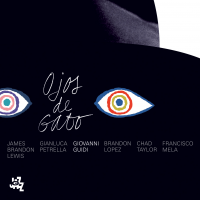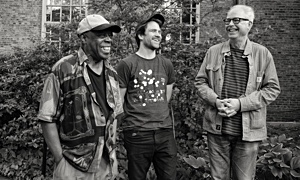Home » Jazz Articles » Six Picks » 2021’s Overlooked and Underrated Gems
2021’s Overlooked and Underrated Gems
 Giovanni Guidi
Giovanni Guidi Ojos De Gato
CAM Jazz
2021
In a year where saxophone roots-revivalist James Brandon Lewis made headlines everywhere —topping multiple year end lists for his collaboration with the Red Lily quartet on Jesup Wagon (among numerous placements in jazz publications around the globe for that album and for Code of Being on Intakt Records)—his expressive saxophone playing on the remarkable new effort by Italian pianist Giovanni Guidi has flown largely under the radar. Quite surprisingly so, as the quality of the music does not only speak for itself, but the other musicians on the album should also attract attention— Gianluca Petrella being among the most talked about trombonists of the past decades and Chad Taylor—a close collaborator of Brandon Lewis— being an equally prominent name. Moreover, there's plenty of resemblance here to the sound Lewis has been exploring lately, even if it's not immediately apparent. Ojos de Gato is a fierce endeavor, a homage to late Argentinian tenor legend Gato Barbieri and an individual artistic statement in equal parts, combining the roughest spectrum of soaring horns with the gradual and lyrical glide of Latin rhythms within one single breath. Like Brandon Lewis' Jesup Wagon, the album is the opposite of overproduced. It's rough around the edges, unpolished in its expression and structurally open, leaving plenty of room for spontaneous interaction, exclamations and other forms of melodic explorations—all contributing to it's convincing, confident and sincere nature. Guidi amasses heavy storms as he digs into the lower range of the piano with heft, leaving most of the melodic lead to trombone and saxophone as he maps out lively terrains and explores dense and spacious landscapes for improvisation. In the process, the pianist and his group not only traverse various musical idioms, but dive deep into the Latin-American and Italian topographies, constructing a bridge between the two cultures as they seemingly arrive at their music's essence. In a way, this collection of music does the same thing as Jesup Wagon, as both leaders appear to be on similar missions, digging into the roots of musical languages that appear to be distant relatives.
 Gonzalo Rubalcaba, Ron Carter, Jack DeJohnette
Gonzalo Rubalcaba, Ron Carter, Jack DeJohnette Skyline
5Passion
2021
Admittedly, this album doesn't quite fit into the categories "underrated" or "overlooked" as this supergroup-trio not surprisingly made a bit of a splash upon its autumn release last year. However, as time has never moved faster than it does today with releases forgotten in the blink of an eye and Jack DeJohnette, Ron Carter and Gonzalo Rubalcaba not having sounded this good in any context in a long time, it only seems appropriate to once again point out how special Skyline really is. It's everything one would expect from the quality and experience these players share, minus the slight disappointment all-star pairings tend to entail, as the whole doesn't always amount to the sum of its parts. Well here it does exactly that, and then some. Packed with artful originals and two classic Cuban cancións by José Antonio Méndez and Miguel Matamoros, Rubalcaba, Carter and DeJohnette elegantly wash over their instruments like soft waves over sand, carefully tossing notes and bars like grains, leaving behind smooth surfaces for minds to sink into. DeJohnette's ride and snare playing has rarely sounded subtler than on his self-penned "Silver Hollow," Rubalcaba's technical dexterity rarely as controlled and impassioned as on his own "Promenade" and Ron Carter, at 84 (81 when the album was recorded in 2018), remains at the top of his game with perfect intonation, inspired solos and his signature serenity throughout any challenge. Most of the material is both balladic and upbeat at once, presenting extensive arcs of tight and patient interplay to swinging exchanges within one structure. Carter's "Quite Place" is a brief highlight in a line of many, putting the spotlight on Rubalcaba's tasteful change-navigation and the production's translucent sonic qualities, with spark, snap and crunch. DeJohnette's "Ahmad The terrible," first recorded for his 1984 band Special Edition on ECM Records, in the version found here sounds closest to the language of the man the tune pays homage to, as Rubalcaba has obviously spent much time studying and diving into he depths of Ahmad Jamal's unique dialect. There's something to be said about each performance on this record, however simply listening to it is unquestionably the best way to get the complete, impressive picture.
 Wadada Leo Smith's Great Lakes Quartet
Wadada Leo Smith's Great Lakes Quartet The Chicago Symphonies
TUM Records
2021
In the year of his 80th birthday it was harder than ever to keep up with horn-guru Wadada Leo Smith's unquenchable output, with material pouring out from the prolific spiritual mind like water melting off a glacier (an analogy that holds truer each day). And while many eyes were on him and his countless releases with Tum Records—A Love Sonnet For Billie Holiday with Jack DeJohnette and Vijay Iyer being among the most prominent examples —, the sheer volume of music made it easy for some of it to fall between the cracks. Released in the same wave as the trio record with Iyer and DeJohnette, The Chicago Symphonies belongs among those slightly overlooked musings. And missing out on it would be a crucial mistake for several reasons: for one thing, the four CD-album comes in beautiful packaging featuring an introduction by acclaimed jazz-writer John Litweiler, a transcription of a Barack Obama speech held at the 50th anniversary of the Selma to Montgomery marches as well as other assorted texts regarding the Great Lakes Quartet and its individuals —Henry Threadgill, John Lindberg, and Jack DeJohnette, plus saxophonist Jonathon Haffner, who features on the last disc. Then there's the remarkable abstract and textural art work by one of Finnland's leading modernist painters, Anti Lavonen, five of whose paintings are presented in the box—one on its cover, and four additional ones for each CD. More essentially and obviously though, The Chicago Symphonies are filled with beautiful, adventurous and culturally-charged music, harking back to the likes of Don Cherry and the AACM. Smith has always put a focus on the holistic approach to music—one that takes mind, body and socio-political dynamics into account, as much as the musical ones. More than a musical construct, it's also a geo-political statement, a music that digs into its unique past with regard to the demographics and locations that formed it. Each symphony—Gold, Diamond, Pearl and Sapphire—takes on the form of a different jewel, with its own characteristic cut, color and contour, represented by different extents of freeness, varying musical subjects and alternating configurations of interplay, leading to different shapes and figures as the movements are constantly changing appearance. It's the type of music that is constantly in motion, without an agenda as to what it's supposed to be but rather with a philosophical outlook towards what it can be. An essential document of Smith's singular explorations that sits well alongside a rich discography of creative output with small groups and ensembles (which is also neatly illustrated in the back of the booklet accompanying the box- set release).
 Kyle Shepherd
Kyle Shepherd After The Night, The Day Will Surely Come
Matsuli Music
2021
On his first solo record, the South African pianist and composer Kyle Shepherd ties together a number of compositions from his back-catalogue with improvised pieces in an intimate piano solo set, constructing extensive structures with a dramaturgy that encompasses multiple temperaments and idioms within one underlying arc. Shepherd and the piano keys seem to gel easily —the notes rolling off from the tips of his fingers in a fluent motion, with the softest attack and swiftest action. Keith Jarrett is an obvious reference, not only because of the format or the opening homage to the pianist, captioned "For Keith," but because Shepherd's first gentle, then dashing enthusiasm recalls the earlier, mostly lyrical solo recitals of Jarrett in the '70s, captured on numerous studio and concert recordings. Speaking of "capturing"—After The Night, The Day Will Surely Come is exceptionally well recorded, presented in a simultaneously clear and warm sonic design that lets the listener trace each note from the stroke of the key to the reflection in the room—Shepherd's voice tracing his piano's melodies included. Stylistically, the pianist traverses everything from rhythmic gospel loops and loose balladry to intense explorations of touch and sound, engaging the piano's higher register with precisely executed flourishes and minimalist arpeggios. Shepherd's melodic inclinations are infectious and his phrasing subtle and smooth, weaving through harmonic frameworks with zest as he turns his own compositions into new meditations, re- configuring the melodies naturally in the process. Neither showy piano playing, nor aimless banter as sometimes found in this format, After The Night, The Day Will Surely Come is a beautiful, if discreet recording of one of South Africa's most exciting current musicians, working both in jazz and scoring films. The record is a vinyl exclusive release and should also be considered among the nominations for album cover of the year 2021.
 Tomoko Omura
Tomoko Omura Branches Vol 2
Outside in Music
2021
Violinist Tomoko Omura's Branches Vol 1. (Outside In Music, 2020) was a hit, and so is the second volume. Tracing her own cultural roots back through Japanese folk music, Omura's recent work (starting with Roots on Inner Circle Music, in 2015) has been focused around compositions directly inspired by Japanese folktales and folksongs. Omura talks about the individual stories that inspired the respective music in the liner notes and recalls wondersome tales, some of which deal with animals, others with humans; the subtext is always positive and so is the music. "Come Firefly" is a Japanese folksong and begins with a marching snare drum before the refrain intervenes, featuring sung lyrics. Omura soars beyond the vocals, her bow and strings swiftly curving through the air like, well, fireflies ("Come, come, come Firefly, the water there is bitter, the water here is sweet"). There's a breezy, wondrous element to "Melancholy of a Crane"—an Omura-original—in the way the harmonic progression seems to go on and on and on, one prudent tension triggering the next, never quite resolving and inviting pianist Glenn Zaleski in for a beautifully constructed solo, before Omura takes over and repeats the same trick, but in her own language. Music that wouldn't be misplaced accompanying pictures from film director Hayao Miyazaki. There's some straight-ahead swinging too, pulling though the ultra-driven "To Ryan Se" and with "Tomie's Blues" the album features an outstanding blues ballad that shifts rhythms like the mind does through time—Omura dedicates the song to her late grandmother, expressing the elasticity of time in the song's rhythmical fabric. Haunting violin arpeggios introduce "Bow's Dance," originally a folksong of the Ainu people from the northern part of Japan, here transformed into another string of progressions, first harmonic ones, then rhythmically gaining momentum and crescendoing into a physical workout for the entire group. It's worth researching Umeka Ando, a celebrated but little known Ainu singer who Omura mentions in the liner notes and whose version of the song is another marvelous discovery in its own right. On her path of discovering her roots, Tomoko Omura's Branches offer wonderful insight into her music and the music she's inspired by.
 Chet Doxas
Chet Doxas You Can't Take It With You
Whirlwind Recordings
2022
Tradition comes in many shapes and forms, and while a saxophone trio with bass and piano doesn't scream "classic jazz format," it does come with a history, not least pioneered by the Jimmy Giuffre 3. But again, tradition can reveal itself in manifold ways, and does so colorfully on You Cant Take It With You, hidden in the structure in one moment, in a phrase the next and then in the way lines intersect and instruments interact. Saxophonist Chet Doxas appears to have much respect for tradition in any art-form, and most of all for specific artists' ideas that were able to catapult the tradition forward into new dimensions. In the liner notes to the album Doxas speaks of Count Basie, Lester Young, Jim Hall and Johnny Green but also mentions writer Mark Twain and painter Joan Miró as inspirations for his compositions. And of course his mentors, Carla Bley and Steve Swallow must not be neglected, which in turn brings us back to the Jimmy Giuffre 3. Accompanied by pianist Ethan Iversen and Thomas Morgan on bass, Doxas transforms a rich variety of exercises in range, technique, tone and structure into independent entities of their own, relying solely on the art of three-way conversation. Each player here has enough experience to play through the real book upside down and in every key, but the qualities truly proving of their greatness here are patience and restraint. The fewer notes they play, the broader their vision and the tighter their interplay become. There are plenty of highlights to choose from, but the swinging and softly dissonant blues "Twelve Foot Blues" and Hitchcock-ian "The Last Pier," with its murder-mystery subject running though it, would have to be on the top of any list. There's something very Monk-esque about Iversen's stubbornness on the latter tune, diatonically climbing up the scale in dragging quarter notes with the nonchalance of a man who's got nothing left to prove.
Tracks and Personnel
Ojos De GatoTracks: Revolución; Latino America; Buenos Aires; Ernesto; Padres (a Papà e Gato); Manhatten (a Carla e Dollar); Roma 1962 (a Enrico e Franco); Paris Last; Café Montmartre (a Aldo e Don); Laura; Ojos De Gato (a Christian).
Personnel: Giovanni Guidi: piano, Fender Rhodes; James Brandon Lewis: saxophone; Gianluca Petrella: trombone; Brandon Lopez: double bass; Chad taylor: drums; Francisco Mela: drums, percussion.
Skyline
Tracks: Lagrimas Negras; Gypsy; Silver Hollow; Promenade; Novia Mia; Quite Place; Ahmad The Terrible; Siempre Maria; Ronjackruba.
Personnel: Gonzalo Rubalcaba: piano; Ron Carter: double bass; Jack DeJohnette: drums.
The Chicago Symphonies
Tracks: Disc 1: Movement 1: Light Fields And Circles: Amina Claudine Myers; Voices. Movement 2: Joyful, Sound And The Numbers; People: The Art Ensemble Of Chicago: Movement 3: Pastoral: Joseph Jarman, As If It Were The Season Of Seasons; Sherry Scott, Voice; Thurman Baker, Charlie Clark And Christopher Giddy. Movement 4: Creative Music; West End Blues And The Sonic Wealth Bird: Louis Armstrong, Earl Hines, Lil Hardin And Baby Dodds. Movement 5: Star-Fields: The Secretary, John S. Jackson. Disc 2: Movement 1: The Rare Air Songs In Sonic Forms And Metrical Folding: Henry Threadgill, Steve McCall And Fred Hopkins. Movement 2: Chicago: Culture, Creativity And The Artistic Passion; A Profile Of The Next Generations. Movement 3: Muhal Richard Abrams: Levels And Degrees Of The Light Spectrums; A New Culture: The Association For The Advancement Of Creative Musicians. Movement 4: Jack DeJohnette: A Special Edition, New Directions And The Sonic Rhythm Units. Disc 3: Movement 1: For Alto; In The Orchestra: NJM 488; Anthony Braxton: Operas. Movement 2: Leroy Jenkins Mixed Quintet Sonics: Dance Opera. Movement 3: Heliocentric Sun Ra Energy And Particles Of Light. Movement 4: Jupiter Skies: Kelan Phil Cochran And The Chicago Kulture. Movement 5: Scented Yellow And Red Chrysanthemums; Wadada Leo Smith: The Bell In Silence Resonants And Ten Freedom Summers. Disc 4: Movement 1: Abraham Lincoln, The 16th President Of The United States Of America. Movement 2: Abraham Lincoln At Gettysburg: Two Seven Two, 1863. Movement 3: The Visionaries, Abraham Lincoln And Barack Hussein Obama. Movement 4. Barack Hussein Obama At Selma: The Bridge Of Transformation. Movement 5: Barack Hussein Obama, The 44th President Of The United States Of America.
Personnel: Wadada leo Smith: trumpet, flugelhorn; Henry Threadgill: alto saxophones, flute, bass flute; John Lindberg: double bass; Jack DeJohnette: drums; Jonathon Haffner: alto and soprano saxophones (Disc 4).
After The Night, The Day Will Surely Come
Tracks: Side A: For Keith -Desert Monk -Reinvention/Johannesburg -Sweet Zim Suite -Coleen's Rose -Buddy's Well of Beauty; Side B: Dazuifu -Cry of the Lonely— Desert Monk II—Zikr.
Personnel: Kyle Shepherd: piano.
Branches Vol. 2
Tracks: Come Firefly; Melancholy Of A Crane; To Ryan Se; Bow's Dance; Tomie's Blues; Urashima Suite.
Personnel: Tomoko Omura: violin; Jeff Miles: guitar; Glenn Zaleski: piano; Pablo Menares: bass; Jay Sawyer: drums.
You Can't Take It With You
Tracks: You Can't Take It With You; Lodestar(For Lester Young); Part Of A Memory; Cheryl And George; Twelve Foot Blues; The Last Pier; Soapbox; Up There In The Woods; All The Roads; View From A Bird.
Personnel: Chet Doxas: saxophone; Ethan Iverson: piano; Thomas Morgan: bass.
Tags
Six Picks
Pat Youngspiel
James Brandon Lewis
Giovanni Guidi
Gianluca Petrella
Chad Taylor
Gato Barbieri
5Passion Records
Jack DeJohnette
Ron Carter
Gonzalo Rubalcaba
Ahamd Jamal
TUM Records
Wadada Leo Smith
Vijay Iyer
Henry Threadgill
John Lindberg
Jack DeJohnette
Jonathon Haffner
Don Cherry
Matsuli Music
Kyle Shepherd
Keith Jarrett
Outside In Music
tomoko omura
Glenn Zaleski
Whirlwind Recordings
Jimmy Giuffre
Chet Doxas
Count Basie
Lester Young
Jim Hall
Johnny Green
carla bley
Steve Swallow
Ethan Iversen
Thomas Morgan
PREVIOUS / NEXT
Support All About Jazz
 All About Jazz has been a pillar of jazz since 1995, championing it as an art form and, more importantly, supporting the musicians who make it. Our enduring commitment has made "AAJ" one of the most culturally important websites of its kind, read by hundreds of thousands of fans, musicians and industry figures every month.
All About Jazz has been a pillar of jazz since 1995, championing it as an art form and, more importantly, supporting the musicians who make it. Our enduring commitment has made "AAJ" one of the most culturally important websites of its kind, read by hundreds of thousands of fans, musicians and industry figures every month.
























